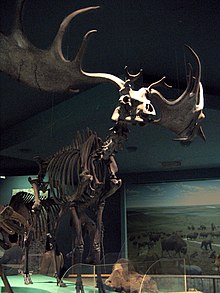Megaloceros giganteus
The Irish elk, giant deer or megaloceros (Megaloceros giganteus) It was the largest cervid in history. Similar to a large fallow deer, its antlers measured up to 3.5 m from end to end. Although it lived throughout Europe and much of Asia from half a million years ago until its recent extinction, it is often popularly known as the "Irish elk" for the abundant finds of specimens preserved in the peat bogs of Ireland.
Description
The giant deer reached a height of 2.2 m at the withers in males, much higher than the largest living elk. It was a species with strong sexual dimorphism, as the females were considerably smaller and more graceful than the males, in addition to lacking their impressive antlers.
Traditionally, the size of the antler of the Irish elk has been considered exaggerated. Drawings in old books in which the giant deer appears entangled with its own antlers in the undergrowth are not uncommon, thus being easily captured by cave lions or primitive men. But in reality, giant deer were animals that lived in the open tundras and steppes and not in closed forests like European deer and fallow deer. The giant deer did not become extinct because of its antlers, which, like modern deer, were only worn in autumn and winter, during the rutting season. According to studies by paleontologists such as Stephen Jay Gould, the Megaloceros had antlers that corresponded to its size.
Rock art shows possible evidence of changes in hair color and length depending on the time of year. It seems that in summer the hair was shorter and of a brown, reddish or fawn color; in winter, with fully developed antlers, it turned dark brown on the neck, legs and back, being white or yellowish on the face, throat and belly. On the shoulders there was a darker area that extended drawing two lateral lines towards the neck, which crossed to form a "necklace" dark in the middle of it, and two others to the sides.
Habits
Giant deer were grazing animals that fed on abundant grasses and shrubby plants on the great, cold plains that covered Eurasia during much of the Pleistocene. It is probable that in the coldest periods of winter they withdrew slightly towards the southernmost parts of their area of distribution. Adult individuals only had the cave lion, Neanderthal man and modern man as habitual predators. Young or sick individuals could also fall prey to wolves, hyenas, and bears.
As evidenced by their strong sexual dimorphism, giant deer were polygamous. Like other cervids, it is likely that males assembled harems of females in the mating season after fighting head to head with other rival males, and that at the end of winter these groups dissolved, the female being the sole caretaker of her only breeding.
Numerous skeletons of young males indicate that males stopped eating during the rutting season and concentrated exclusively on fighting and reproducing, just as European deer do today. As a result, there were many deaths among the males during the breeding season, especially in the case of young individuals who easily succumbed to the greater strength of the mature ones and died after sheer exhaustion without ever reproducing. In addition, the calcium and phosphate requirements to form the antlers favored cases of osteoporosis among male Irish elk, so mortality, already high, increased in bad years. Flora changes in warm periods deprived the species of the necessary minerals in several areas where the population was reduced or became extinct.
Evolutionary history
Like the other megacerines, the Irish elk has its origins in the steppes of Asia. The species is first recorded from Central Asia and Eastern Europe almost half a million years ago. Dependent on cold, dry weather and open environments, the giant deer spread across Europe in cold periods, when the glaciation worsened, and withdrew to its area of origin in warm ones. At their greatest extent, giant deer reached Ireland and the Iberian Peninsula, but they never set foot in America, as did other animals such as the steppe bison and the mammoth.
With the end of the ice ages, the species declined rapidly. Its extinction was originally estimated to be around 10,600 years ago, along with that of most of the world's megafauna, but in 2000 remains were discovered on the Isle of Man and southern Scotland dating to around 7,500 BC. C. Apparently, a small population had followed the ice in its retreat to the north and had been isolated there, becoming extinct upon the arrival of human hunters from the south. In 2004 there was an even more sensational discovery: thousands of km away, at the foot of the Ural Mountains in Russia, even more modern remains were found, showing evidence of the existence of giant deer in western Siberia up to around 5000 BC. C. Its extinction coincides with a series of alterations in the terrain that were not caused by Paleolithic hunters, but by the first Neolithic farmers in Russia. Thus, the Irish deer survived the ice age.
Gallery
External links (in English)
- Giant Elk survive the freeze (BBC)
- Extinct Giant Deer survive the Last Age, study says (National Geographic)
Contenido relacionado
Stenohaline
Diapedesis
Metaplasia






